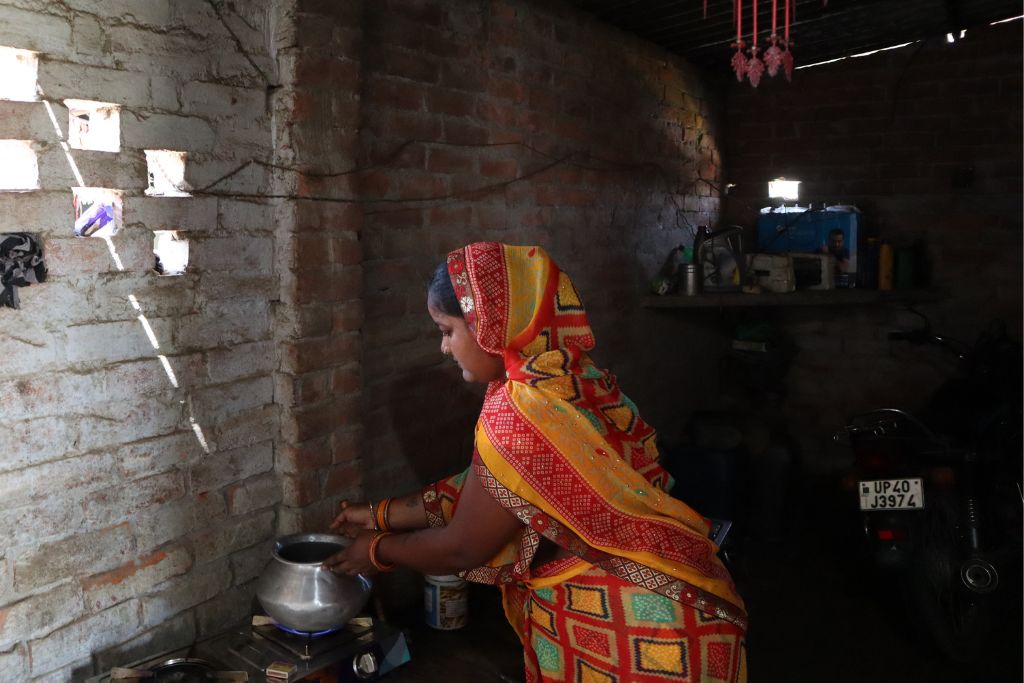
Rural women breathe easy in the kitchen, thanks to biogas
Women in UP’s Bahraich district regularly faced breathing problems and watery eyes when they used wood-fired stoves for cooking. But now biogas produced from cow dung has made cooking easier, faster and cheaper.
Pushpa Devi (26), a resident of Basauna Mafi village in Bahraich district of Uttar Pradesh, spends her days like most women in rural India do. First, she sweeps and cleans her three-room house and the spacious courtyard, which is surrounded by fields of maize and vegetables. Then, she cooks for her family of four and packs the lunchboxes of her school-going children.
Before she leaves the house to go and work in the fields, Pushpa Devi does something that sets her apart from the others in the village. She feeds cow dung into her biogas production unit. The biogas helps her cook for her family. She learnt about biogas from the Aga Khan Foundation (AKF). So AKF has been promoting biogas as a cooking fuel.
Installed in May last year, the biogas unit has a capacity of two cubic metres, and requires 30-35 kg of cow dung to be fed into it. It can produce enough gas for a family of six to cook thrice a day. Pushpa Devi feeds around 10 kg of cow dung, twice daily, into the biogas unit. The slurry that is the by-product of this process is used as fertiliser in her vegetable fields. It adds nutrition to the crops, keeps the soil damp and fertile, due to which less water is required for irrigation.
As many families own cattle in villages, cow dung is generated in large quantities. When disposed of in the open, and in large quantities, cow dung releases methane, a greenhouse gas. Converting the cow dung into biogas for cooking ensures that it is used sustainably.
As she made tea, Pushpa Devi pointed towards the flame to show its intensity. Since it’s very efficient, cooking is quicker than before. She earlier used to cook on a traditional chulha, or a wood-fired stove. It meant felling trees at times and collecting firewood, which was laborious and time consuming. She is now happy that she contributes in a small way to reducing carbon dioxide emissions and preventing deforestation.
For Pushpa Devi, who used to spend Rs 1,200 a month on refilling gas cylinders, the cooking fuel expenditure has vastly reduced. She had to invest Rs 8,000 for the biogas set-up. It will last 10-15 years. The money she has saved through the use of biogas is used for her children’s education and the family’s other needs. “Women can also bring change in the world, even if it is through small things. And for me, my children are my world,” she said. She is happy to be cooking with biogas, since it ensures a healthier home environment for her two children, free from air pollution.
When Pushpa Devi meets the other women, she makes it a point to tell them about her sustainable cooking set-up. She saves nearly Rs 15,000 a year after switching to gobar gas as cooking fuel. She lets the women cook in her kitchen, with the hope that the ease of cooking and cost savings would convince them too to switch to biogas. For she knows that it would preserve the delicate rural environment, as much as the rural families.
The lead image at the top shows Pushpa Devi cooking on a biogas-run stove in her kitchen at Basauna Mafi village in Bahraich district of Uttar Pradesh.
This story has been covered as part of a special collaboration between Village Square and the Aga Khan Foundation to highlight stories of change under the Aspirational District Programme supported by the Induslnd Bank’s Flagship CSR initiative.
Text and photos by Sukanya Roy






